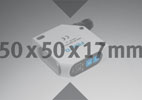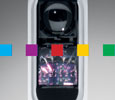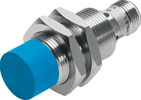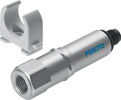

Sensors form an important and integral part of any automation system. Just as the human body relies on its senses to function optimally, so too does a machine.
Traditionally, the sensor industry has been dominated by small to medium sized companies targeting specific parts of the market. However, structural changes are driving larger companies to become involved in this market. Festo has determined that there is a new trend calling for a 'one stop shop' where all automation products are available from a single vendor.
Rapid growth in the size of the sensor market is attributed to competitive pressures for improved performance in process industries, and to new sensor technologies that are experiencing tremendous success. The South African sensor market is mirroring the rapid worldwide expansion and Festo is offering smart sensors in an inductive sensor range, an optoelectronic sensor range and a pressure sensor range to satisfy this demand.

Inductive sensors
Inductive sensors are used for contactless sensing of metal objects and are often employed on printing presses, conveyor systems, robots, elevators and automatic welding machines. The inductive sensor has many advantages over conventional mechanical limit switches as there is no physical contact with the product being sensed; it has no moving parts and can achieve much higher switching frequencies. Festo inductive sensors are available in a variety of materials including stainless steel, polyamide and Teflon coated types, making them resistant to environmental influences and offering an extended service life. Because the units are fully encapsulated they can be used in demanding environments, exposed to splash water, cleaning emulsions, oil and lubricants.
Conventional inductive sensors contain a ferrite core which limits the frequency response and sensing range; however, the Festo SIEF Factor 1 sensor, so named because it detects all metal types at the same sensing distance, contains an emitter coil. This creates a magnetic field that induces voltages in the receiver coils and enables this model to operate at up to 500% faster switching frequency than conventional designs.

The omission of the ferrite core also means that Factor 1 sensors can operate in zones with high electromagnetic interference, for example welding applications. Teflon coated (SIEF.WA) versions are available where sensors need to be protected from welding sparks. Factor 1 sensors operate in the temperature range -30°C to +85°C.
The SIEA is an inductive sensor with an analog output, which is proportional to the distance between the profile of the working piece and the sensor. A change in the output indicates a change in the shape or distance of the object. This sensor can precisely detect changes in a profile over its 0 to 20 mm measuring range due to its 0,01 mm repetition accuracy.

Optoelectronic sensor range
The optical range of sensors makes use of a red light, infrared light or laser light source. They employ one of three different sensing principles: through-beam, retro-reflective and diffused.
In through-beam sensors the transmitter and receiver are located in different housings and installed opposite one another. Each object that breaks the light beam between transmitter and receiver is detected. This type of sensor has a working range of 20 m and is considered a very reliable measurement method. Applications include edge detection on conveyor belts found in the paper and textile industry.
In retro-reflective sensors the transmitter and the receiver are situated in the same housing and the transmitted light is returned to the receiver by means of a specially designed reflector. The sensor is activated when the reflection is interrupted. Festo retro-reflective sensors are available in standard and auto-collimation versions. In the latter the sender and receiver are positioned in the same optical path within the sensor. This version eliminates blind spots and permits the detection of transparent objects such as glass and plastic.
Diffuse sensors use the light reflected from the physical object being sensed rather than from a reflector. These sensors are available in five different types, standard diffuse, distance sensor, background suppression sensor, colour sensor and contrast sensor.
The distance sensor uses a position sensitive detector to calculate the exact distance between the sensor and the object being sensed. This information is available as a 4-20 mA analog output.
The diffuse sensor with background suppression makes use of similar technology to provide a digital output. The position-sensitive device detects the distance between the sensor and the object and can detect the smallest differences in distance. This type of sensor is necessary where it is necessary to detect a poorly reflective object against a highly reflective background.
The diffuse colour sensor uses a white LED to shine a beam of light onto the target. The reflected light carries a signature of the object's colour and the sensor then measures the percentages of red, green and blue (RGB) in this reflection to determine the actual colour of the object. Three separate colours can be sensed at one time.
The diffuse contrast sensor can distinguish between different shades of grey on a particular object. This sensor uses laser light technology and can detect tiny lines or printing marks, small objects under diffuse light and even the presence or absence of internal or external threaded surfaces, as on nuts, bolts and tapped holes.
All-fluid pressure sensor
The SDET is the first pressure sensor available from Festo that works on all liquid and gas media. Comprising a stainless steel housing, ceramic sensing element and Viton seals, it supports all fluids and gases that do not affect the material up to 100 bar pressure. This sensor range operates at medium temperatures up to 100°C and is available with 0-10 V or 4-20 mA analog outputs.

Trends
Festo is continuously researching and developing sensors to meet market demands and changing customer needs. The future calls for compact sensors that sense at higher frequencies, longer distances and increased temperatures. A fibre-optic sensor range is planned towards the end of 2008.
Ernst Smith, product manager - sensors, says, "I am excited about what is available in the range and believe that we have the perfect combination of features for most industry specific requirements."
For more information contact Joanne Dix, Festo, +27 (0)11 971 5560, [email protected], www.festo.com
| Tel: | 08600 FESTO (33786) |
| Fax: | +27 11 974 2157 |
| Email: | [email protected] |
| www: | www.festo.co.za |
| Articles: | More information and articles about Festo |

© Technews Publishing (Pty) Ltd | All Rights Reserved